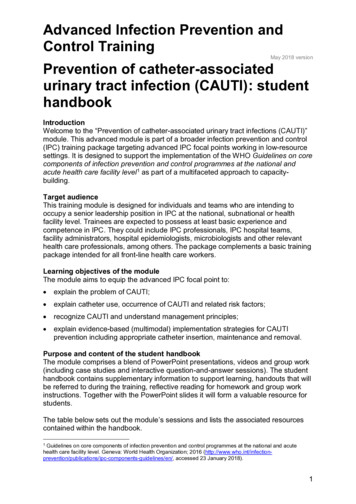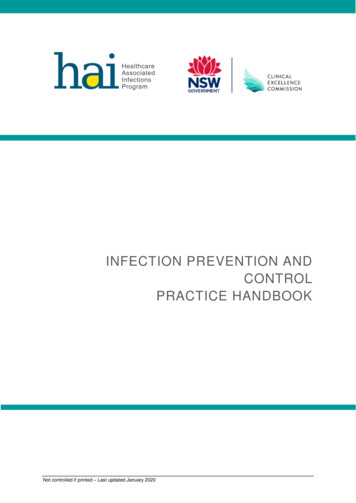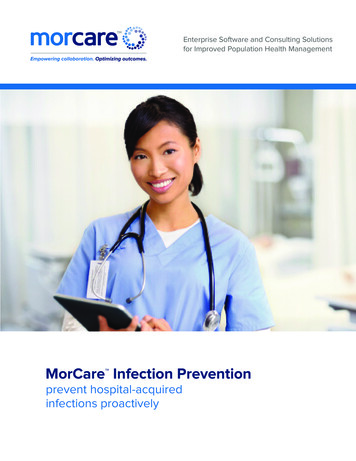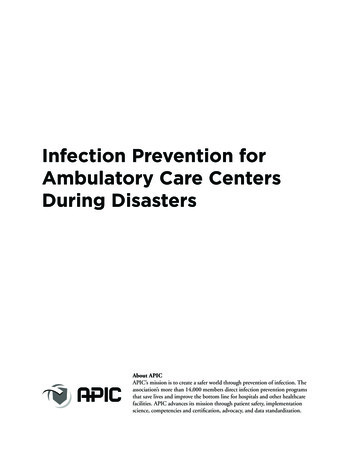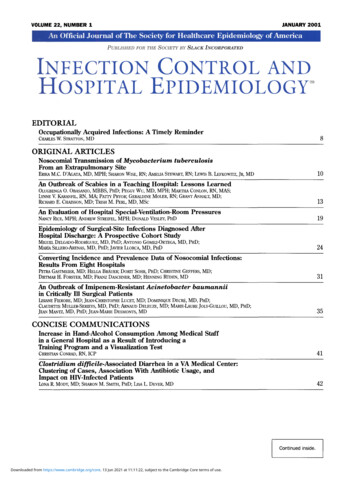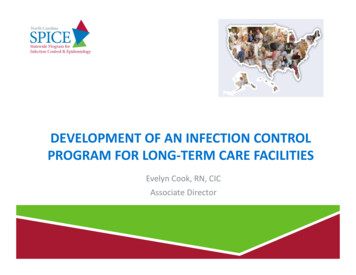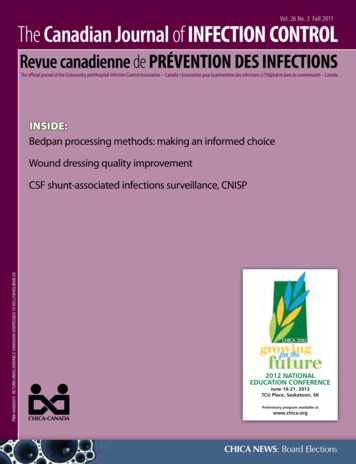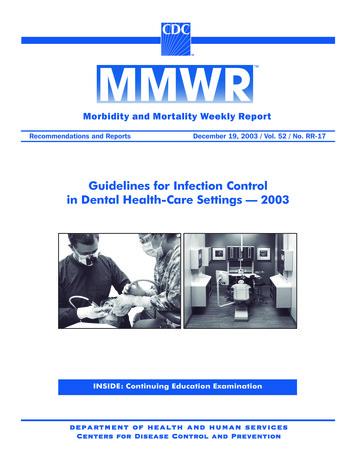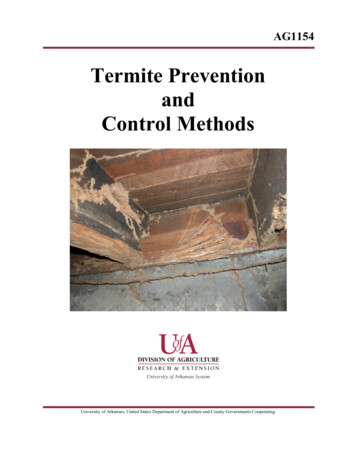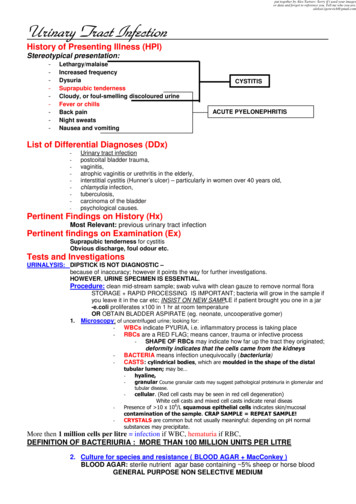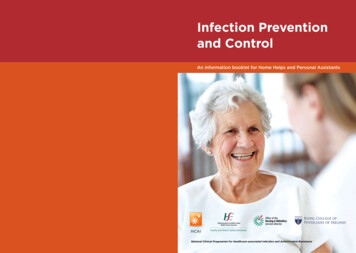
Transcription
Infection Preventionand ControlAn information booklet for Home Helps and Personal AssistantsNational Clinical Programme for Healthcare-associated Infection and Antimicrobial Resistance
The purpose of the booklet is to outline: The importance of applying infection prevention and controlprinciples in the home The infection prevention and control practices to provide a safeenvironment for clients and staff One’s own role in relation to infection preventionThis booklet is designed to be a useful resource for staff. It does notreplace the need for staff to receive face-to-face training and is nota comprehensive infection prevention and control guideline.Staff seeking further information should refer to their local infectionprevention and control guidelines by contacting their line manager, localPublic Health Nurse or Infection Prevention and Control Nurse.This booklet is reproduced and adapted with the kind permission ofthe original authors: Liz Forde, Patricia Coughlan and Máire Flynn(Community and Disability Infection Prevention and Control Nurses inHSE South (Cork & Kerry). This booklet is endorsed by the InfectionPrevention Society Ireland Community Group.The Office of the Nursing and Midwifery Services Director funded theprinting of the booklet.This booklet has been approved by the Royal College of PhysiciansHealthcare-associated Infection and Antimicrobial Resistance ClinicalAdvisory Group (RCPI HCAI/AMR CAG).Version 1.0 June 2014Permission to reprint this booklet is not required. However nomodifications or adaptations to layout or wording should be undertakenwithout the approval of the RCPI HCAI/AMR CAG.ContentsAbout infection prevention and control3Staff health and hygiene5 Personal hygieneCaring for your handsShould you be at work?Staff immunisations: are you covered?Hands and hand hygiene 8When do I carry out hand hygiene?How do I wash my hands?What do I need to carry out hand hygiene?Using alcohol hand rubTop tips to take care of your handsHand hygiene techniqueSneezing and cough etiquette12Personal protective equipment12 When should I wear gloves?When are gloves not needed?How do I remove my gloves safely?What type of gloves should I use?When do I wear aprons?How to safely use gloves and apronsWhen would I wear face masks or eye protection?Routine cleaning in the home What is needed for cleaning?What is needed for disinfecting?Some top tips for cleaningClient equipment16INFECTION PREVENTION AND CONTROLAbout this bookletThis booklet aims to provide home helps and personal assistants withcommon sense information on infection prevention and control. Familycarers may also find elements of this booklet useful.1
19INFECTION PREVENTION AND CONTROL How should I handle laundry in a client’s home? How should laundry be washed?2Managing blood or body fluid spills21Managing sharps22Managing a needle-stick injury and blood/bodyfluid splashes23Managing pets25Pest control25When should I contact my line manager?26Useful websites26Test your infection prevention and control knowledge27Bibliography28About infectionprevention and controlInfections are caused by germs such as bacteria, fungi or virusesentering the body. They can be minor and stay in one area, like a boil,or their effects can be felt throughout the body, like flu. Often, infectionsare easily dealt with, but sometimes they can cause serious problems.The guidance on infection prevention and control in this booklet isdesigned to protect you and the clients you are caring for. The approachis based on the possibility that all body fluids can pass on infectionand people do not always have signs of infection. Body fluids refer toblood, all secretions and excretions except sweat. The body fluids morecommonly encountered when providing client care in the home areurine and faeces.Examples of how infection can spread in this way are: A person may carry salmonella in their faeces without any signsof infection. They may then contaminate food by not washing theirhands after using the toilet thus spreading salmonella to othersthrough this food A person may be infected with a blood borne infection e.g. HepatitisB, which could be transmitted to others by direct contact with theirblood, e.g. shared use of razors or a needle- stick injuryINFECTION PREVENTION AND CONTROLWashing clothes at home3
Standard Precautions are a set of protective measures designed toprevent contact with blood and body fluids of any other person.INFECTION PREVENTION AND CONTROLThe infection prevention and control measures or StandardPrecautions include the following: Staff health, hygiene and staff immunisations Hand hygiene Sneezing and cough etiquette When to wear gloves, aprons and masks/goggles Cleaning of the home and client care equipment Care with laundry Dealing with body fluids safely Care with needles (sharps) Dealing with a needle-stick injury or blood orbody fluid splashes onto eyes or broken skin4Infection controlstarts with meStaff healthand hygieneA high level of personal hygiene and appropriate immunisationsprovides good baseline protection for healthcare workers and helpsprevent the spread of infection.Personal hygiene Carrying out hand hygiene regularly while at work will protect youand the clients that you care for from the risk of cross infection.Refer to the Hand Hygiene section Short sleeves or rolled up sleeves must be worn to ensure that youcan carry out hand hygiene correctly Hair should be clean, away from your face and avoid touching itduring personal care Wear clean work clothing each day which should bemachine washable Outdoor clothing such as jackets, coats and scarves should beremoved while providing client care Enclosed foot wear should be worn to protect from injurye.g. no sandals or flip flopsCaring for your hands Any cuts or scrapes should be covered with a waterproof plaster Finger nails should be short and clean with no gel/false nails ornail polish Any skin problems i.e. dermatitis should be reported to your linemanager who will refer you for medical/occupational health advice Protect your hands by using a water-based moisturiser Wrist jewellery or rings with stones should not be worn whileproviding care; a flat band/wedding band is acceptableINFECTION PREVENTION AND CONTROLIn order to protect yourself and the clients you care for, infectionprevention and control measures called Standard Precautions shouldbe used by: all staff for the care of:- all clients- all the timeregardless of whether you know if the person has or has not gotan infection.5
Infectious diseases in staff can be readily transmitted to susceptibleclients. Respiratory infections e.g. the flu, can be transmitted to clientsdirectly by respiratory secretions when coughing or sneezing orindirectly from your hands.Diarrhoea or vomiting illness can also be transmitted to clients by yourhands on items you have touched or on food that you have handled.If you have gastrointestinal or respiratory symptoms, a fever or skinrashes please consult your GP. If your illness is suspected to be ofan infectious nature, please inform your line manager who may seekoccupational health advice.INFECTION PREVENTION AND CONTROLStaff immunisations: are you covered?6It is essential that ALL healthcare workers/carers’ employed (permanentor temporary capacity) by the HSE are assessed by the OccupationalHealth Department pre-employment or as soon as possible followingcommencing employment. The National Immunisation AdvisoryCommittee recommends specific vaccinations for healthcare workersbased on a risk assessment. This assessment will be undertaken by theOccupational Health Department.Contact your line manager/home help coordinator to arrangethis service.By receiving the vaccines recommended you will be protecting: Yourself Your family Your clients Your work colleaguesThe need for the following vaccinations will be considered duringyour assessment:Hepatitis B Hepatitis B vaccination isadvised if you are at risk ofcontact with blood, body fluidsor at risk of needle-stick injuryMeasles/Mumps/Rubella (MMR) The occupational health teamwill assess if this vaccinationis required. A blood test maybe undertakenInfluenza/Flu The flu vaccine is offered toall healthcare staff during theinfluenza season each year, andit is advised that all staff whodeliver care and have directcontact with clients shouldreceive this vaccine annuallyPertussis (whooping cough) The occupational health teamwill assess if a booster doseis requiredVaricella (chicken pox) The occupational health teamwill assess if this vaccinationis requiredBCG BCG is a vaccine againsttuberculosis. The occupationalhealth team will assess if thisvaccination is necessary.A skin or blood test may beundertaken to decide if youneed a BCG vaccineIf you have concerns about exposure to an infectious illness, discusswith your line manger who may seek advice from the occupationalhealth team.INFECTION PREVENTION AND CONTROLShould you be at work?7
Hands andhand hygieneREMEMBEREncourage and assist your clients to wash their hands, particularlyafter using the bathroom and before they eat.INFECTION PREVENTION AND CONTROLWhen do I carry out hand hygiene?8Hand hygiene must be carried out: On arrival to the home Before any personal careactivities such as bed bath,shower, assisting client toget dressed Before any clean task such asassisting a client to brush theirteeth, opening a urinary catheterbag and before preparing/handling food Before putting on gloves ifneeded during direct clientcare. See Glove Section forinformation on when glovesshould be worn whendelivering care After contact with body fluidssuch as handling soiled bedlinen, emptying commodes/ urinals. Gloves should beworn for these tasks and handhygiene must be undertakenwhen gloves are removed (seeGloves section)After any personal care activitiessuch as washing and dressingthe clientAfter contact with areas/items in the home likely to becontaminated during householdduties e.g. bins or cleaningcloths, toilets, touching petsWhen leaving the home whencare is finishedAfter personal bodily functionssuch as blowing your nose orusing the toiletAfter smokingHow do I wash my hands? Wet your hands under warm running water Apply liquid soap into a cupped hand and rub palms together to workup a lather Using the steps described on page 11, wash all hand surfaces severaltimes, remembering palms, back of hands, finger tips, between fingersand thumbs and wrists Remember to wash and rinse under your ring, if worn Rinse your hands under running water Pat hands dry with good quality paper towels that are softand absorbent Don’t forget to dry under your ring It will take 40-60 seconds to wash and dry your handsWhat do I need to carry outhand hygiene?If liquid soap and kitchen paper towels are available in the home, thesecan be used for handwashing. If they are not available, discuss with yourline manager or the nurse coordinating the clients care for supplies. Barsoap is not recommended.Alcohol hand rubs are sometimes recommended for use in homes.They are only effective if hands look clean. Alcohol hand rubs are noteffective against all germs for example, clients with Clostridium difficileINFECTION PREVENTION AND CONTROLHands are one of the most common ways in which infection can bespread. Keeping your hands clean is one of the best ways to keep youfrom getting sick and/or preventing the spread of illness. Cleaningyour hands gets rid of germs you pick up from other people, from thesurfaces you touch and from the animals you come in contact withand prevents these germs being spread to others. Just because handslook clean, we can’t assume that they are clean. To reduce the spreadof infection it is important that hand hygiene is carried out at the righttime and in the right way.Before carrying out hand hygiene, ensure you: Cover any cuts or grazes with a waterproof plaster Keep your fingernails short, clean, no gel or false nails and free ofnail varnish Take off your watch and any jewellery such as bracelets – one flatband/wedding ring is acceptable9
If alcohol hand rubs are recommended for client care, the need forsupplies must be discussed with either your line manager or the nursecoordinating the clients care. Only alcohol hand rubs approved by theinfection prevention and control team are to be used in a client’s home.Using alcohol hand rubINFECTION PREVENTION AND CONTROL If your hands look clean, use an alcohol based hand rub wheresupplied Apply a sufficient amount of rub to cover hands Using the steps shown on page 11, rub the alcohol hand rub into allareas of your hands for a minimum of 20 to 30 seconds Ensure your hands are completely dry before carrying out anothertask. Do not use paper towels to dry hands Do not use alcohol hand rub if your hands are dirty or if you are caringfor clients with diarrhoea. In these scenarios, wash your hands withsoap and water Alcohol hand rubs do not need to be used after washing your hands10REMEMBERIf alcohol hand rubs are recommended for the care of your client: Keep in a safe place Do not place alcohol hand rub dispensers adjacent to electricalfittings or direct heat e.g. near lamps or heaters Do not store alcohol hand rub near sources of high temperaturesand flames as alcohol is flammable If you have a skin condition on your hands e.g. weeping dermatitisseek advice from your line manager who will refer you for medical/occupational health advice. Direct client care is not advisable if youhave skin conditionsHand hygiene techniqueWet hands thoroughly under running water. Apply soap, rub palmstogether to work up a lather, then:Rub palm to palmRub back of left hand with right hand withinterlaced fingers and then use left hand to rubback of right handRub palm to palm with fingers interlacedRub backs of fingers (interlocked)Rub both thumbsTop tips to take care of your hands Moisturise your hands regularly to protect the skin from
Wet your hands under warm running water Apply liquid soap into a cupped hand and rub palms together to work up a lather Using the steps described on page 11, wash all hand surfaces several times, remembering palms, back of hands, finger tips, between fingers and thumbs and wrists Remember to wash and rinse under your ring, if worn Rinse your hands under running water .
